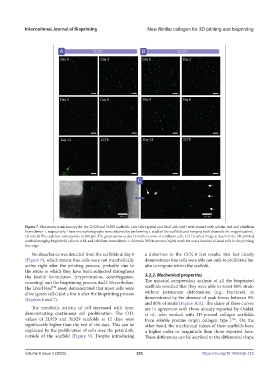Page 331 - IJB-9-3
P. 331
International Journal of Bioprinting New fibrillar collagen for 3D printing and bioprinting
Figure 7. Fluorescence microscopy for the 2L929 and 3L929 scaffolds. Live cells (green) and dead cells (red) were stained with calcein-AM and ethidium
homodimer-1, respectively. These microphotographs were obtained by performing z-stack of the scaffolds and merging both channels (4× magnification).
(A and B) The scale bar corresponds to 200 µm. The green arrow at day 12 marks a zone of confluent cells. (C) Detailed image at day 0 of the 3D-printed
scaffold merging brightfield, calcein-AM, and ethidium homodimer-1 channels. White arrows (right) mark the exact location of dead cells in the printing
line edge.
No absorbance was detected from the scaffolds at day 0 a distortion to the CCK-8 test results, this fact clearly
(Figure 9), which means that cells were not metabolically demonstrates that cells were able not only to proliferate but
active right after the printing process, probably due to also to migrate within the scaffold.
the stress to which they have been subjected throughout
the bioink formulation (trypsinization, centrifugation, 3.2.2. Mechanical properties
counting) and the bioprinting process itself. Nevertheless, The uniaxial compression analysis of all the bioprinted
the Live/Dead assay demonstrated that most cells were scaffolds revealed that they were able to resist 80% strain
TM
alive (green cells) just a few h after the bioprinting process without permanent deformation (e.g., fractures), as
(Figures 6 and 7). demonstrated by the absence of peak forces between 0%
and 80% of strain (Figure 10A). The shape of these curves
The metabolic activity of cell increased with time, are in agreement with those already reported by Osidak
demonstrating continuous cell proliferation. The O.D. et al., who worked with 3D-printed collagen scaffolds
values of 2L929 and 3L929 scaffolds at 12 days were from soluble porcine origin collagen type I . On the
[28]
significantly higher than the rest of the data. This can be other hand, the mechanical values of their scaffolds have
explained by the proliferation of cells over the petri dish, a higher order or magnitude than those reported here.
outside of the scaffold (Figure 9). Despite introducing These differences can be ascribed to the differential shape
Volume 9 Issue 3 (2023) 323 https://doi.org/10.18063/ijb.712

